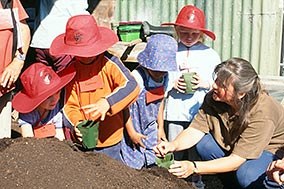 Children enjoying bush games.New Zealand native plants don’t grow anywhere else in the world. They tell us a lot about the nature and history of our country. Why not extend the classroom into your school grounds? Find out more about creating a small native forest, planting a shelterbelt and attracting native birds at your school. Learn about the things that make living in Southland so special. Find out about creating an edible garden at your school.
Children enjoying bush games.New Zealand native plants don’t grow anywhere else in the world. They tell us a lot about the nature and history of our country. Why not extend the classroom into your school grounds? Find out more about creating a small native forest, planting a shelterbelt and attracting native birds at your school. Learn about the things that make living in Southland so special. Find out about creating an edible garden at your school.
Benefits of a native garden
There are many benefits to having a native garden in your school, including:
-
 School children learn how to pot up plants.Providing an attractive environment for enjoyment and recreation
School children learn how to pot up plants.Providing an attractive environment for enjoyment and recreation - Providing habitat for wildlife and attracting native birds.
- Providing learning about the creatures that live in a garden
- Providing plants for “touch”, “smell”, “shape”
- Involving children in growing plants from seed at the Community Nursery
- Involving children in designing their own garden for the school – including paths, signs, picnic tables, etc.
- Building weta boxes, bird feeders, bird nesting boxes, a worm farm.
Creating a small native forest
When creating a forest large or small, we have to follow nature. The process of re-colonising a bare patch of land is called ‘succession’. Colonising or nursery species (also called primary or pioneer species) grow well on bare ground in open sites. They are hardy, easy to grow and will generally tolerate extremes in temperature, terrain, soil type and drainage. They provide the perfect habitat for forest canopy species to establish and grow.
Examples of Southland colonising species include manuka, mingimingi and cabbage trees. Find out more about How Forests Work.
Check out our Forest Restoration Planting List for recommended species.
Creating a shelterbelt
Shelterbelts can improve your school grounds by providing a physical barrier to reduce wind speed and improve the local micro climate. However, shelterbelts can also provide important habitats for native insects and birds. Find out more about planting shelterbelts.
Attracting native birds
 Kereru - native wood pigeon.A great way to enhance your school is to choose native plants and trees that will attract native birds. At different times of the year, different parts of a tree will be utilized, such as, flowers and nectar, fruit and leaves. Also consider places for birds to nest, such as dense shrubberies and tall trees. Find out more about planting to attract native birds.
Kereru - native wood pigeon.A great way to enhance your school is to choose native plants and trees that will attract native birds. At different times of the year, different parts of a tree will be utilized, such as, flowers and nectar, fruit and leaves. Also consider places for birds to nest, such as dense shrubberies and tall trees. Find out more about planting to attract native birds.
Edible gardens
A great way to get students involved in a garden project is to create an edible garden. Not only do they learn where their food comes from, they get the enjoyment and satisfaction of growing their own. Check out Edible Gardening for Schools for:
- Ideas and issues for school gardens
- Links to the curriculum
- Ideas on what to plant and when
- Information about heritage species.
Educational resources
Find out about Enviroschools and how your school can be involved.
Check out the Ministry of Education’s Education for Sustainability for more ideas about incorporating the environment into your school’s curriculum.
Find out more about New Zealand’s unique fauna and flora from the Department of Conservation and the Royal Forest and Bird Protection Society of New Zealand.
Find out more
Contact us for more information and advice about planting at your school.
